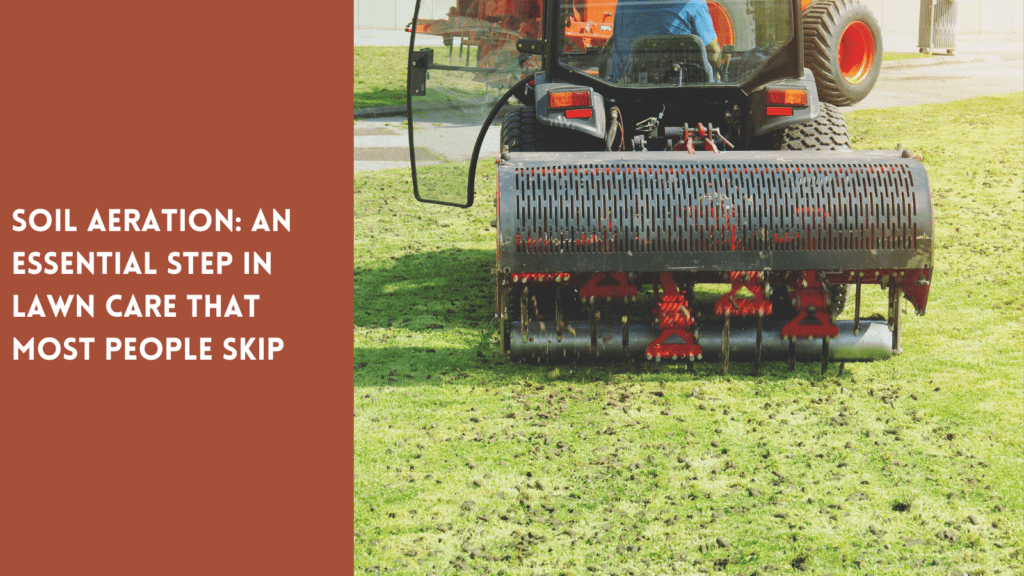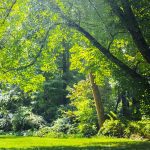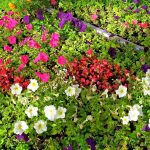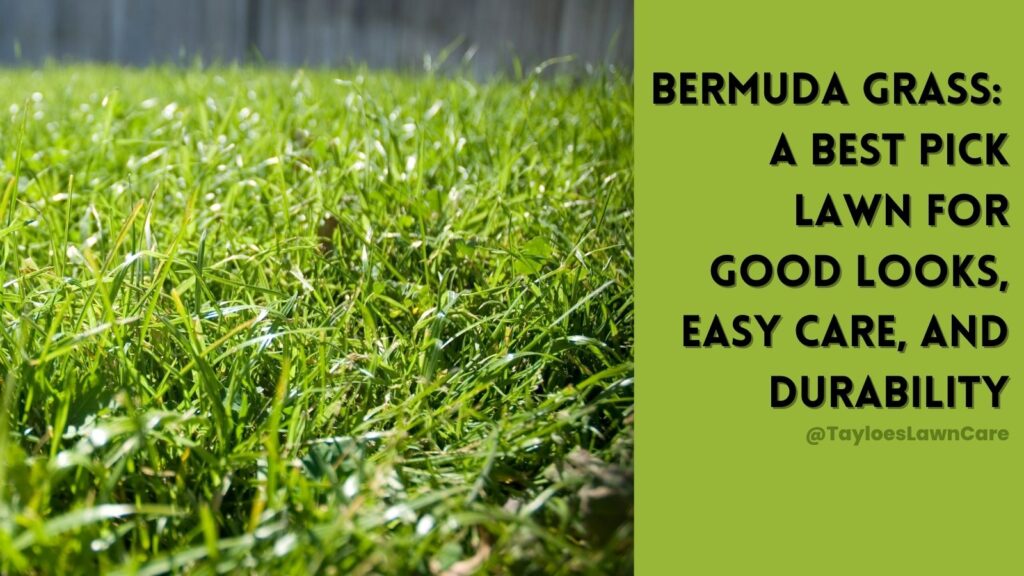Last Updated on: 15th April 2025, 05:46 am
Find the best grass species for shaded areas.
In Eastern North Carolina, where warm temperatures and high humidity are the norm, even the best-kept yard can struggle when dealing with a tricky shady spot. Whether it’s tree-draped corners, fence-line shadows, or buildings that block the afternoon sun, turf in low-light areas often ends up thin, patchy, and tired.But, shady spots don’t mean surrender. Growing grass in shady areas is possible when you find the best shady area grass seed.
You can create a lawn that feels cool, lush, and inviting — even beneath the leafy canopy of mature trees. This guide walks you through understanding your shade type, choosing the best grass seed for your space, and laying the groundwork for lasting success.
Understanding the Shade in Your Yard
Before you choose a grass seed, take a moment to understand the kind of shade you’re working with. Not all shade is the same, and the type of shade your lawn receives directly affects how well different grasses will grow.
Types of Shade You’ll Commonly See in NC Yards:
Dappled Shade
You’ll get this shade under tall, high-branching tree plants like oaks or elms. Sunlight filters through the leaves, creating shifting patches of light and shadow. Most shade-tolerant grasses grow well in these light conditions.Partial Shade
These areas get 3 to 5 hours of sunlight daily, often in the morning or late afternoon. Think of the eastern or western side of your home.Full Shade
Receives less than 3 hours of direct sunlight per day. Standard near dense tree lines, tall fences, or other structures — including buildings. Only the most shade-tolerant grasses will grow here.Deep (Heavy) Shade
Occurs under thick evergreen cover or between tall structures. With little direct sunlight, grass rarely succeeds, and ground covers are usually the better choice.
Pro Tip: Spend a day watching how sunlight moves across your yard. Note which areas stay shaded the longest — that’s your biggest clue when selecting the right grass seed for each shady spot.
Choosing the Best Grass Seed for Your Shade Type
Once you’ve established what kind of shade you’re dealing with, picking the right seed becomes much easier. Below is a selection of popular grass seed options with high shade tolerance that perform well in Eastern North Carolina’s warm, often humid climate — each suited to different levels of light and lawn needs.
Quick Summary Table: Best Shady Area Grass Seeds for Eastern NC
| Grass Type | Shade Tolerance | Best For | Climate Suitability | Notes |
|---|---|---|---|---|
| Creeping Red Fescue | ★★★★☆ (Full to dappled) | Under trees, garden edges | Cool-season, NC transition | Low maintenance; great for low-traffic lawns |
| Fine Fescue Blend | ★★★★★ (Deep to partial) | Mixed shade, tree-lined areas | Cool-season, NC transition | Combines chewings fescue, creeping red, and hard fescue; best overall for deep shade and flexibility |
| Tall Fescue (Turf-Type) | ★★★☆☆ (Partial shade) | High-traffic areas with limited light | Cool-season, heat-tolerant | Durable and drought-resistant |
| Kentucky Bluegrass | ★★☆☆☆ (Light shade only) | Open areas with morning sun | Cool-season; prefers cooler areas | Often blended with fescues for versatility |
| Perennial Ryegrass | ★★☆☆☆ (Partial shade) | Quick over-seeding, bare spot repair | Cool-season; short-lived in heat | Germinates fast; needs more care |
| Rough Bluegrass | ★★★★☆ (Full to deep shade) | Damp, cool, shady spots | Cool-season | Sensitive to heat; best used in blends |
A Closer Look at Each Grass Type
1. Creeping Red Fescue
Creeping red fescue is one of the most reliable performers in shady spots. Its fine blades and creeping growth habit create a soft, lush turf with a uniform blade length that pairs well with other grasses. It thrives with minimal maintenance, ideal for low-traffic, out-of-the-way areas. Once established, it tolerates poor soils and resists drought.
2. Kentucky Bluegrass
Loved for its rich color and dense growth, Kentucky bluegrass brings a manicured look to lawns — but it needs more sun than most shade-friendly varieties. In Eastern NC, it’s best used as part of a blend, where it adds visual appeal and durability. Keep an eye on its moisture needs during hot, dry spells, as it tends to go dormant without regular watering.
3. Perennial Ryegrass
As one of the fastest-establishing cool-season grasses, perennial ryegrass is your go-to when you need quick, visible results. Whether overseeding, repairing bare spots, or giving your lawn a timely refresh, it delivers rapid germination and a burst of vibrant green. Its fine texture blends seamlessly with other cool-season grasses, enhancing thickness and overall appearance in just a few days.
4. Fine Fescue Blend
This blend of fine fescue grasses — including chewings fescue, hard fescue, and creeping red fescue — is built for shady spots. It adapts easily to shifting light, needs little mowing, and keeps its color even in poor soil. For lawns with mature trees, patchy sunlight, and minimal foot traffic, it’s a dependable, low-maintenance option.
5. Tall Fescue (Turf-Type)
Rugged, versatile, and heat-tolerant, turf-type tall fescue is an excellent fit for active households. Its deep roots provide resilience during dry spells, and its broad leaves create a fuller look than most fine fescues. It performs well in moderately shady spots and stands up to kids, pets, and weekend backyard fun — keep it trimmed and fed.
6. Rough Bluegrass
Rough bluegrass can thrive where most grasses fail — cool, damp, heavily shaded spots with poor airflow. It forms a soft, fine-textured turf that looks great in spring and fall but struggles in the heat. For the best outcome, use it as part of a seasonal or transitional blend in areas that stay consistently cool and moist.
How to Set Up Your Shady Lawn for Success
Even the best shade-loving grass seed won’t thrive if the soil isn’t adequately prepared. Shady spots can be tricky — with compacted soil, aggressive plant roots, and limited airflow. But with a little prep, you can set the stage for a healthy, resilient lawn.
1. Clear the Clutter and Let in the Light
Start by raking up leaves, moss, and weeds. Then, grab some pruning shears and trim back low tree branches or thick shrubs. Even an extra hour or two of sunlight can make a big difference when growing grass in shady spots.
2. Loosen the Soil
Shady soil is usually compacted—especially near trees. Use a core aerator or a sturdy rake to break up the top 4–6 inches. An aerated lawn allows better airflow, improves drainage, and helps grass roots access the necessary nutrients. Be gentle around big roots, but do your best to open things up so your shady grass has room to thrive.
3. Add Organic Matter
Mix in a thin layer (about ½ inch) of compost or well-aged manure to enrich the soil. It improves structure, supports healthy root growth, and helps retain just the right amount of water. If needed, add sand or leaf mold to enhance drainage.
4. Do a Quick Check (Optional but Helpful)
Testing your soil’s pH is essential before beginning if your lawn has had trouble growing. Most shade-tolerant grasses thrive in a pH range between 6.0 and 7.0. You can adjust with lime or sulfur if needed, and applying a starter fertilizer initially gives your grass the boost it needs.
5. Rake It Smooth
Once the soil is loose and rich, finish by raking it into a fine, even surface. This helps your grass seed settle in and sprout evenly.
Sowing
You’re now ready to plant. Be sure to follow the label instructions on your seed bag — they’ll guide you on application rate, planting depth, mowing length, and aftercare, all of which vary depending on the grass type.
Pick a calm, mild day, preferably in early fall or spring.
Spread the seed evenly using a broadcast spreader or by hand for small areas.
Lightly rake the seed into the top ¼ inch of soil to ensure good contact.
Cover with a thin layer of mulch (like straw) to help retain moisture and protect the seed.
Irrigate gently and regularly for consistent moisture until germination. Avoid overwatering — shady spots don’t dry out as quickly.
How to Maintain a Healthy Shaded Lawn
Once your grass has sprouted, the goal shifts to supporting its long-term health. Shaded lawns require a slightly different approach than sunny ones — less watering, less feeding, and more patience.
Water carefully: Shady areas dry out more slowly, so you won’t need to irrigate as often. Once established, aim for deep irrigation once or twice a week — always in the early morning.
Mow high: Set your mower to an optimal blade length of 3–4 inches. Taller grass collects more light, which supports the process of photosynthesis and strengthens the roots. Also, avoid cutting more than one-third of the blade at a time.
Fertilize lightly: Shaded grass grows more slowly, requiring less fertilizer. Apply a slow-release formula once or twice a year — too much can weaken the lawn.
Watch for moss and weeds: Low light conditions and lingering dampness often lead to moss and broadleaf weed growth. Keep surrounding plants well-pruned to improve light and airflow, and address any moss patches early.
Touch up thin spots: Even healthy shady lawns may need occasional over-seeding. Fall and early spring are the best times to fill bare patches and keep your turf thick and uniform.
Watch out for pests and diseases: Lawns in shady spots are more prone to diseases like mildew, brown patches, and thinning grass due to low light and high humidity. Inspect regularly, improve airflow, irrigate early, and apply targeted treatments as needed to keep your lawn healthy and resilient.
It’s Possible to Grow a Healthy Lawn in a Shady Spot
Shady spots may test your lawn care skills but offer unique beauty.
When you find the best shady area grass seed, prep from the beginning, and provide consistent maintenance, even the darkest corners of your yard can support healthy turf. Every step — from ground preparation to mowing height — contributes to a lawn that feels cool, calm, and lush beneath the trees.
It might take a little extra care, but the result is worth it: a quiet, green haven that stays full and vibrant all season. Need a helping hand? Call or text Tayloe’s Lawn Care Services, LLC: 252.287.3376
Author Profile

- Maureen Abuor
- Maureen Abuor is a professional content marketing strategist and SEO strategist, with particular knowlege of creating landscaping and gardening content that informs and delights her audience. When she's not working, she's a busy mother of three precious little ones and child of God.
Latest entries
 Lawn CareApril 29, 2025Best shady area grass seed for Eastern NC
Lawn CareApril 29, 2025Best shady area grass seed for Eastern NC GardeningApril 15, 2025How do I make organic soil for the garden?
GardeningApril 15, 2025How do I make organic soil for the garden? Flower GardenMarch 7, 2025What are wave petunias?
Flower GardenMarch 7, 2025What are wave petunias? Flower GardenMarch 3, 202520 Full-sun annuals for your spring and summer garden
Flower GardenMarch 3, 202520 Full-sun annuals for your spring and summer garden







